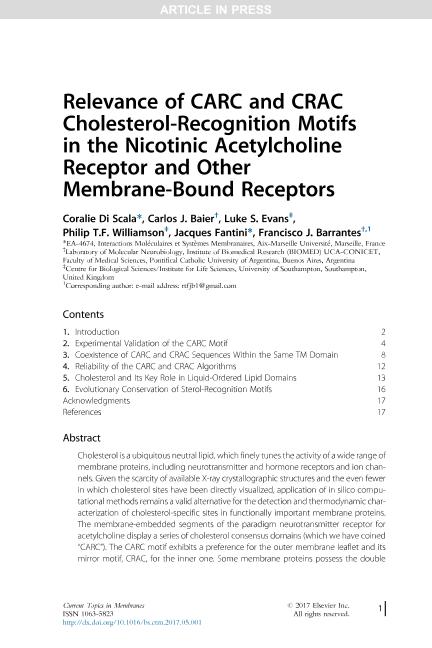Mostrar el registro sencillo del ítem
dc.contributor.author
Di Scala, Coralie

dc.contributor.author
Baier, Carlos Javier

dc.contributor.author
Evans, Luke S.

dc.contributor.author
Williamson, Philip T. F.

dc.contributor.author
Fantini, Jacques

dc.contributor.author
Barrantes, Francisco Jose

dc.date.available
2018-04-06T18:48:33Z
dc.date.issued
2017-07
dc.identifier.citation
Di Scala, Coralie; Baier, Carlos Javier; Evans, Luke S.; Williamson, Philip T. F.; Fantini, Jacques; et al.; Relevance of CARC and CRAC Cholesterol-Recognition Motifs in the Nicotinic Acetylcholine Receptor and Other Membrane-Bound Receptors; Elsevier Academic Press Inc; Current Topics In Membranes; 80; 7-2017; 3-23
dc.identifier.issn
1063-5823
dc.identifier.uri
http://hdl.handle.net/11336/41207
dc.description.abstract
Cholesterol is a ubiquitous neutral lipid, which finely tunes the activity of a wide range of membrane proteins, including neurotransmitter and hormone receptors and ion channels. Given the scarcity of available X-ray crystallographic structures and the even fewer in which cholesterol sites have been directly visualized, application of in silico computational methods remains a valid alternative for the detection and thermodynamic characterization of cholesterol-specific sites in functionally important membrane proteins. The membrane-embedded segments of the paradigm neurotransmitter receptor for acetylcholine display a series of cholesterol consensus domains (which we have coined “CARC”). The CARC motif exhibits a preference for the outer membrane leaflet and its mirror motif, CRAC, for the inner one. Some membrane proteins possess the double CARC–CRAC sequences within the same transmembrane domain. In addition to in silico molecular modeling, the affinity, concentration dependence, and specificity of the cholesterol-recognition motif–protein interaction have recently found experimental validation in other biophysical approaches like monolayer techniques and nuclear magnetic resonance spectroscopy. From the combined studies, it becomes apparent that the CARC motif is now more firmly established as a high-affinity cholesterol-binding domain for membrane-bound receptors and remarkably conserved along phylogenetic evolution.
dc.format
application/pdf
dc.language.iso
eng
dc.publisher
Elsevier Academic Press Inc

dc.rights
info:eu-repo/semantics/openAccess
dc.rights.uri
https://creativecommons.org/licenses/by-nc-sa/2.5/ar/
dc.subject
Carc Motif
dc.subject
Cholesterol
dc.subject
Crac Motif
dc.subject
Ion Channels
dc.subject
Neurotransmitter Receptor
dc.subject.classification
Otras Ciencias Biológicas

dc.subject.classification
Ciencias Biológicas

dc.subject.classification
CIENCIAS NATURALES Y EXACTAS

dc.title
Relevance of CARC and CRAC Cholesterol-Recognition Motifs in the Nicotinic Acetylcholine Receptor and Other Membrane-Bound Receptors
dc.type
info:eu-repo/semantics/article
dc.type
info:ar-repo/semantics/artículo
dc.type
info:eu-repo/semantics/publishedVersion
dc.date.updated
2018-04-04T13:13:11Z
dc.journal.volume
80
dc.journal.pagination
3-23
dc.journal.pais
Estados Unidos

dc.journal.ciudad
Burlington
dc.description.fil
Fil: Di Scala, Coralie. Aix-Marseille Université; Francia
dc.description.fil
Fil: Baier, Carlos Javier. Consejo Nacional de Investigaciones Científicas y Técnicas; Argentina. Pontificia Universidad Católica Argentina "Santa María de los Buenos Aires"; Argentina
dc.description.fil
Fil: Evans, Luke S.. University of Southampton; Reino Unido
dc.description.fil
Fil: Williamson, Philip T. F.. University of Southampton; Reino Unido
dc.description.fil
Fil: Fantini, Jacques. Aix-Marseille Université; Francia
dc.description.fil
Fil: Barrantes, Francisco Jose. Consejo Nacional de Investigaciones Científicas y Técnicas; Argentina. Pontificia Universidad Católica Argentina "Santa María de los Buenos Aires"; Argentina
dc.journal.title
Current Topics In Membranes

dc.relation.alternativeid
info:eu-repo/semantics/altIdentifier/doi/http://dx.doi.org/10.1016/bs.ctm.2017.05.001
dc.relation.alternativeid
info:eu-repo/semantics/altIdentifier/url/https://www.sciencedirect.com/science/article/pii/S1063582317300029
Archivos asociados
